Sand Hills Golf Club
NE, USA
Green Keeper: Justin White
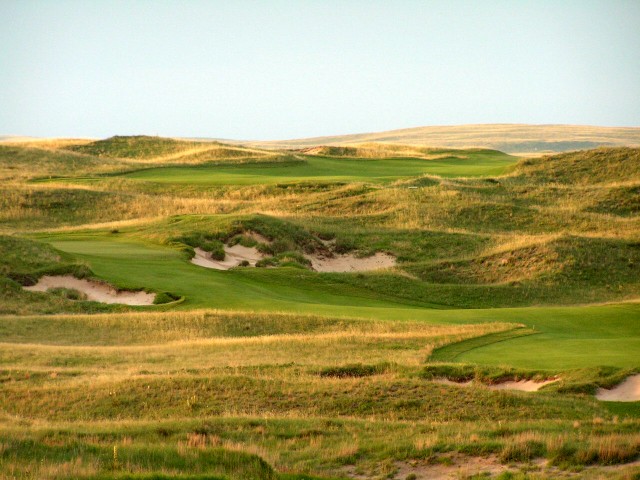
The great Sand Hills of Nebraska – no hype required.
Steeped in history, The Old Course at St. Andrews has a spirtual hold unlike any other, with golfers leaving there more reinvigorated than ever by the joys of the game of golf. For many, the course in the United States that offers a similar reconnectionto all the game’s best attributes is – ironically -just over ten years old.
How can this possibly be, one asks?To understand how, one must appreciate the expansive sand hills range in north central Nebraska where the Sand Hills Golf Club is located. As with the Old Course, the land was shaped by the elements and was largely untouched by man for thousands upon thousands of years. The overall result is that a game at Sand Hills Golf Club immerses the golfer in nature like few courses anywhere in the world.
The credit for finding and providing this primal reunion with nature belongs to Dick Youngs cap and his partners. Youngscap had previously worked with Pete Dye in the eastern part of the state when he founded the Firethorne Golf Club in 1986. Long aware of the great sand hills range and of the Ogallala aquifer, Youngscap searched this unique area for several years looking for property with land forms that might yield holes of high golfing quality.
As Youngscap notes, ‘Not all sand hills are created equally’ and the particular parcel of land that was eventually settled upon was brought to Youngs cap’s attention because of its poor grazing qualities: the sandy soil lacked humus and thus much vegetation, requiring 25 acres to support each cattle.Excellent grazing land consists of soil/vegetation conditions that allow cattle to be supported on just 5 acres per head.
According to the Lodging Information booklet found in each cabin,
In August 1990 an option on 8,000 acres was secured, including the valley in which the golf course is located; the property was purchased in 1991. In September 1990, Bill Coore and Ben Crenshaw made their first site visit and shortly thereafter, they were retained as golf course architects. Over the next two years, Bill and Ben made numerous visits. By the spring of 1993, they had discovered over 130 holes, from which 18 were selected and a routing plan finalized. During 1993, most of the work was concentrated on the irrigation system, which comprises about 85% of the total golf course construction cost. Fairways, greens and tees were developed in 1994, using the following procedure: 1) mowing existing vegetation to ground level; 2) tilling all areas to a depth of 6′; 3) doing some minor finish grading on the greens – rough grading expense was less than $7,000 – primarily with a small power rake; and, 4) applying seed fertilizer and water.
The Lodging Information booklet points out that because of the excellent sand particles, the cost per Sand Hills green was $300 as neither drain tile/gravel under the greens nor special greens mix were required. Put in perspective, the average cost of a USGA specification green is approximately $40,000.
When the course opened in June, 1995, the most natural course built in the United States since World War I had opened.
Consistent with the huge scale of the place, the course enjoys massive fifty to ninety yard wide fairways that weave in and out and over and around the sand hills in every possible manner, much more satisfactorily than the fairways at Royal Birkdale for instance that repeatedly play through valleys. The fairways were seeded with a blend of four fine-blade fescues, which makes for a stunning contrast against the bunkers and the native tan andbrowngrasses blowing in the breeze.
Course critics say that Sand Hills was waiting to be ‘discovered.’ Certainly, Perry Maxwell’s comment re:Prairie Dunes about eliminating one hundred holes applies to Sand Hills. However, these comments are dismissive of the fact that the monumental challenge was to route eighteen consecutive holes that play well together in all wind conditions.
Many architects could find several dozen great holes scattered over the 8,000 acres. However, hole D’s tee might require a three hundred yard walk from Hole C’s green. Or perhaps the architect finds a fine string of six or seven holes only to become boxed into a less appealing portion of the property. Or, lacking the patience to follow nature’s lead, an architect resorts to bulldozing landforms to force a conventional set of holes upon the landscape.
Simply put, routing a course to incorporate as many natural landforms as possibleis an art form that is largely lost on many modern architects, many of whom have frankly never had the chance to develop such a skill set as their work is confined to housing development courses on modest property. Without selecting the right architect, there was no guarantee at all that a great course would be built here. Youngscap and his partners felt it imperative that as many of the natural landforms as possible be included in the design and understood that the right architect would need to spend weeks upon weeks on the property trying to find just such a routing.
Patience would be required by both the owners and the architect. In the case of Bill Coore and Ben Crenshaw, they walked the property for over 24 months before settling on a routing that yielded the best 18 hole sequence. As Coore modestly states in his November 1999 Feature Interview on this site, ‘The Sand Hills site was ideal. The challenge there was to create a course equal to the potential of the land – a daunting task to say the least! To have constructed anything less than an extraordinary golf course on that site would have been a failure.’
Coore & Crenshaw’s patience and sensitivity to the land is a hallmark of their design work and sets them apart from all other architects. At one point when they weren’t making headway toward a final routing, Ben Crenshaw stepped over the then boundary fence (roughly where 11 green and 16 tee are today) and reported back to Coore to come see this next door parcel of land. Shortly thereafter, Youngscap swapped the land owner some land for that parcel and holes 12 through 15 were allowed to be created.
Certainly some of the great sand blow-out areas guided Coore & Crenshaw in the routing process. Among other things,a walk around Sand Hills is a study in hazards, both in bunker placement and bunker construction. Of the courses with which the author is familiar, onlythose at Pine Valley, Royal Melbourne and Royal County Down begin to compare. To even term parkland course bunkers as ‘hazards’ seems to do the word an injustice based on the four photographs below.

This blow-out to the right of what became the 1st green helped Bill Coore find the hole rightaway. Coore & Crenshaw’s talented crew scraped back and exposed more sand to create the bunker of today.
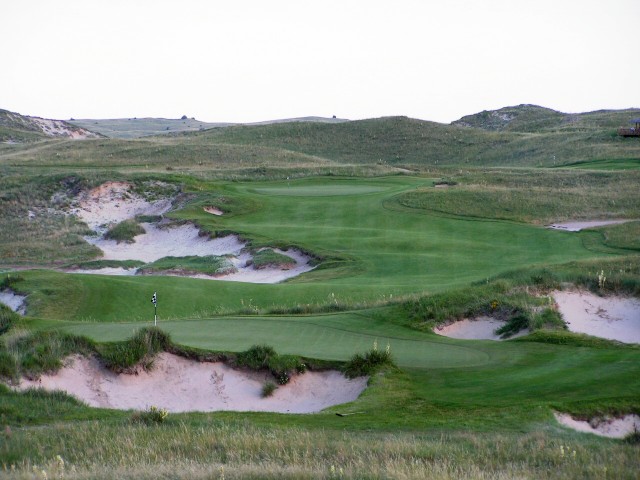
The variety of hazards at Sand Hills is astonishing, ranging from the pits around the 17th green in the foreground to the massive blow-outs up the 18th fairway in the distance…
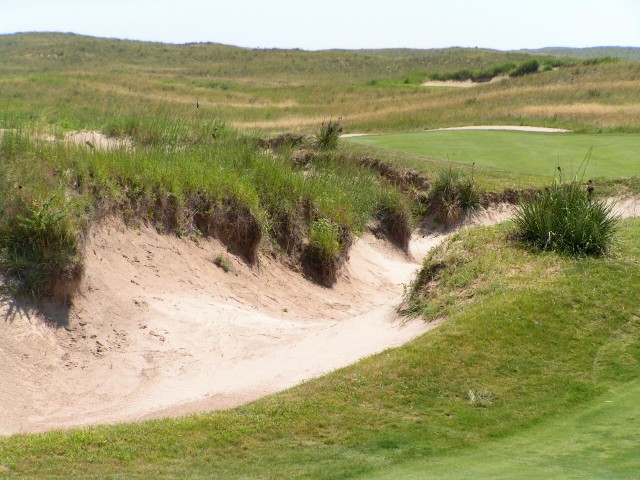
…to this view of a trench bunker 170 yards from the 16th green…
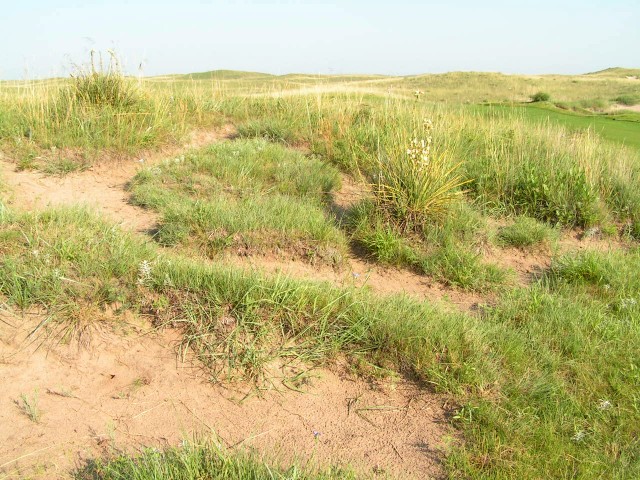
..to a shallow bunker full of ruts 300 yards off the middle markers at the 12th that is in play off the tee in certain wind conditions. Though thirty times (!) shallower than the crater bunker to the left of the 4th green, it is equally as dangerous.
In the foreword to Robert Hunter’s The Links, Bill Coore writes, ‘I have never encountered a more perfect description of the artistic construction of bunkers than the following: [quoting from Robert Hunter] They should have the appearance of being made with carelessness and abandon with which a brook tears down the banks which confine it, or the wind tosses about the sand of the dunes…forming depressions or elevations broken into irregular lines. Here the bank overhangs, where there it has crumbled away.’ The golfer sees from the photographs above that Coore & Crenshaw have employed this philosophy to great success.
With the routing done,another crucial task was getting the detail work right around the greens. Indeed, as diverse and eye catching as the hazards are, they divert attention and praise away from the heart and soul of the design: the green complexes. The diversity found within the greens is of the highest order and is comparable to those of The Old Course at St. Andrews and the West Course at Royal Melbourne.
Coore & Crenshaw re-introduced the all important (and all but dead) art form of tying the entrances of the greens to the greens themselves. The majority of the greens are open in front to allow for the wind, regardless of its direction. However, it is the subtle pitch and roll of the terrain just prior to the greens that give each hole much of its unique playing characteristics. For instance, a slight knob of less than a foot in height lies eight pacesshy ofthe leftpart the 8th green.Its randomness can perhaps propel a ball forward but far more likely than not, it has the habit of kicking balls right into a small gathering central greenside bunker.

The stunning beauty late in the day at Sand Hills is what first registers. At some point, though, the golfer begins to take in and appreciate the variety and joy offered by the green complexes. Pictured above is the 6th putting surface.
Holes to Note
Firsthole, 550 yards; Right at the top with the opening holes at Pine Valley, Machrihanish, National Golf Links of America, Garden City and The Old Course at St. Andrews, the view from the elevated tee of the broad sixty-five yard wide fairway and jagged bunkers contrasted against the tan, rust and brown grasses makesone itch to play. While Coore eventually foundover 130 holes amongst the rolling sand hills, the first three that he immediately ‘saw’ whenhe initially walked the property where the 1st,18th and 17th. The rest of the holes/routing eventually radiated away from these three holes.All three holes enjoy natural green sites, with the 1st and 18th in their own little amphitheaters.

The great sweep of the 1st fairway winds the golfer up toward…

…the green nestled between dunes in the left center of the photograph above.
Second hole, 460 yards; The back marker was added a year after the course opened and stretched the hole from its initial length of 420 yards. As the member tells his guests, there is no prevailing wind at Sand Hills. Thus, one of the challenges that Coore & Crenshaw faced was to create a string of holes that played well in all wind directions. Apart from providing playing width (which they emphatically did), the only way to do so is to provide genuine ground game options for the player. Downwind and the golfer maytry toland the ball ten to thirty yards shy of the putting surface and have it bound up. Into the wind and the player may hit a lower runner that chases the finally thirty or forty yards.Case in point is the second green complex which is as appealing as any green complex that the author has ever seen.
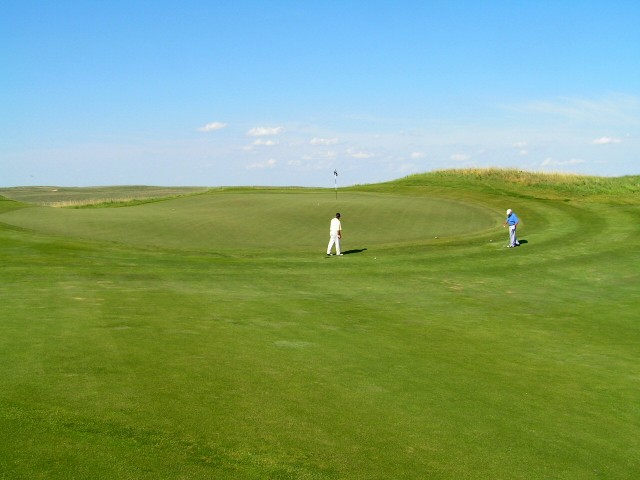
The closely mown high bank to the right of the 2nd green allows the upper plateau to play bigger than it actually is. The sight of golfers at the base of the false front is a common one.
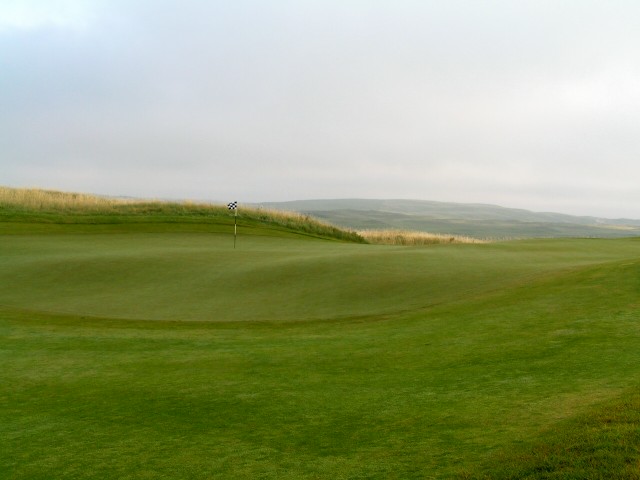
The striking 2nd green and its contours as seen in the early morning.
Third hole, 215 yards; A recent gathering at Sand Hills of ten golf architecture fans failed to produce a consensus as to the favourite one shotter here. Indeed, the group was almost evenly split between the four holes. The defining attribute of the 3rd is the way the green complex was integrated in with a dune on its left. The mammoth 10,000 square foot green yields an untold number of interesting hole locations.
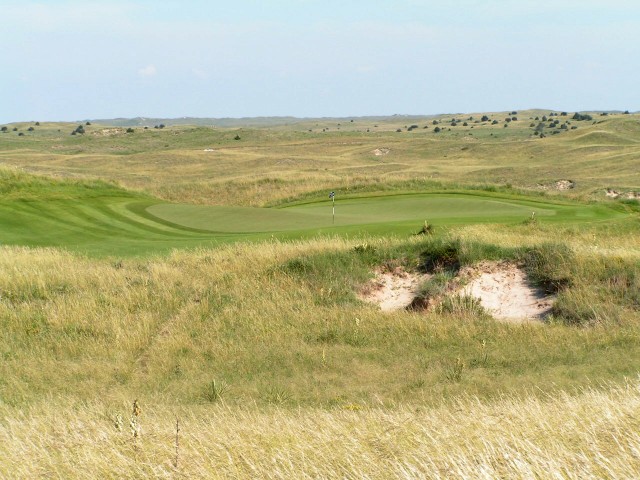
The 3rd green is angled from front left to back right.
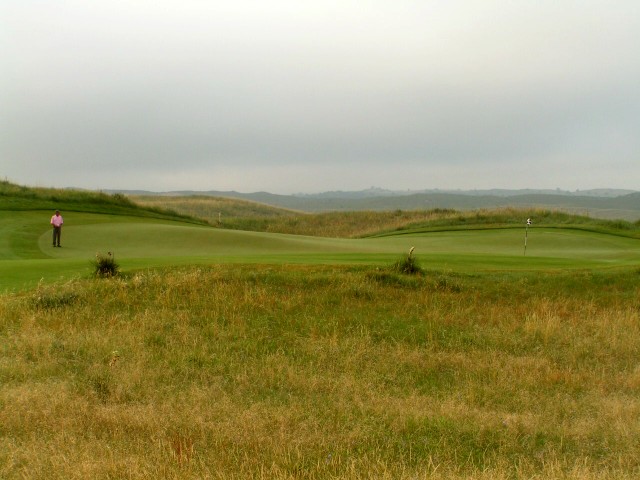
How best way to get close to this hole location? Decisions range from going straight at it to banking a ball from near the man in the pink shirt and feeding it left to right toward the hole.
Forthhole, 485 yards; Afine example of how to bunker – and not bunker – a green. Coore & Crenshaw dug out the huge bunker (more like a 30 foot crater) to the left of the green and used that fill to build up the green complex directly beside it. To the right of the elevated green, the architects provide a tightly mown 40 yard wide area. Thus, a huge range ofrecovery shots exists, from a bunker shot that must quickly climb thirty feet in the air to a bump and run up a hill. If the flag is located to the right, the golfer may also consider missing the green short to avoid a potentially ticklish bump and run shot to a short-sided hole location. Too many modern architects bunker both sides of a green and in front, thus actually forcing the golfer to take dead aim at the green – where isthe strategy in that?? The art of bunkering but one side of a greenis one of the reasons that Royal Melbourne’s design as long been considered amongst the finest in the world.
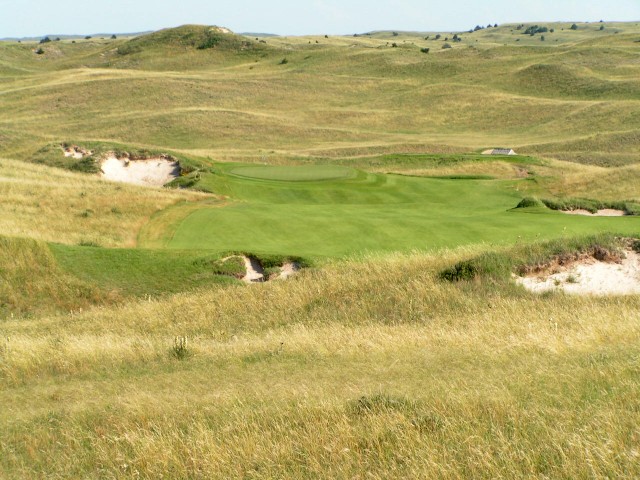
The heroic 4th, as seen from the back markers, as it tumbles sixty feet downhill. The elevated tee means there is no place to hide from the wind on the tee ball.

This view from 160 yards out provides a full view of the tightly mown area right of the built-up green but only the top 1/3 of the course’s deepest bunker is visible to the left of the green.

There is no good reason for missing the 4th green to the left, as this picture suggests. Just the act of getting in and out of this crater can break the spirit of a good man.
Fifthhole,410 yards; The merit of placing a tee at a diagonal to the fairway is evidenced here. The hole is more fascinating from the back tee than the middle tee, simply because of its 45-degree angle to the fairway. Therefore, the line of play differs from day to day (even morning to afternoon), dependent on the wind. The middle tee points more in direct line with the fairway and thus,playsin amore straightforward manner.
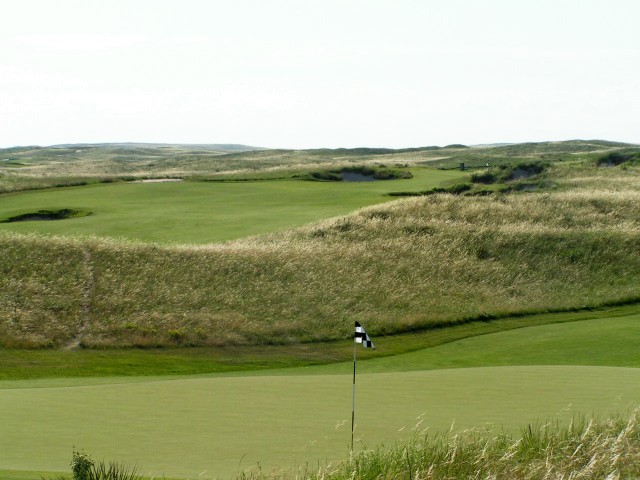
The view over the 4th green from the back markers to the 5th fairway.
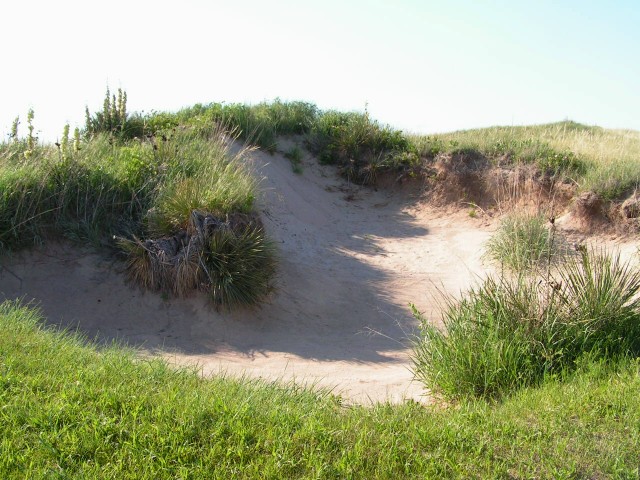
One of the meanest bunkers on the course is on the inside of the dogleg at the 5th; interestingly enough, it is directly in line with the green from the tee.
Sixth hole, 200 yards; On a property with pronounced land forms, blind shots add to the enjoymentand variety of the challenge. However, too many blind shots and a course may ultimately lose some of its appeal. Conversely, too few blind shots andthe opportunity for the architect to create some uncertainty and mystery has been lost.Coore & Crenshawstruck the perfect balance at Sand Hills, with one example being their use of a ridge sixty yardsshy ofthe 6th green that obscures the left front half of the green.
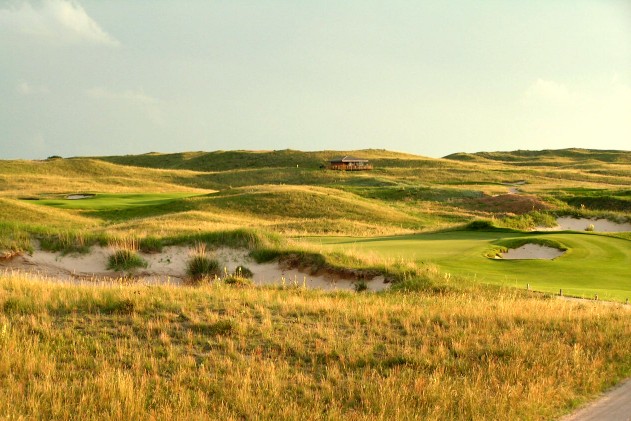
The bunker in the foreground is sixty paces from the front of the green. However, its face is tall enough to obscure the left front of the green to the point where the day’s hole location is blind.
Seventh hole, 285 yards; Nobody comes to Sand Hills Golf Club for just one round. Most members and their guests stay for several days and seemingly one of the worst things that can occur at the start of such a stay is to drive the 7th green. Downwind, this is not an uncommon occurence for a good player. However,the bravado it affordsall but guarantees that the golfer will have a disasteron this hole at another point during his stay, such is the penal nature of the green’s location on a knob and the deepbunker to its left.
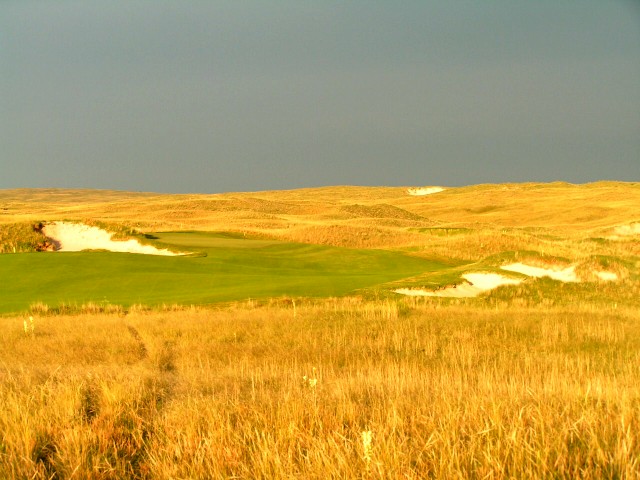
Though a storm is approaching, the view from the 7th tee remains one of tranquility. After a few rounds, the golfer better appreciates the narrow green’s menace with its deep bunker left and sharp fall off right.

A pull from the 7th tee leaves this golfer with a 60 yard lob shot over an eight foot deep greenside bunker to the narrow part of the green that then falls sharply away. Throw in wind and the chance of a satisfactory conclusion to this shot/hole rapidly diminishes.
Eighth hole, 365 yards; Much was initially made of having a pair of short two shotters back to back like this but such comments only highlight the general sad state of golf course architecture in the early to mid 1990s. Two more diversegreen complexes – eachposing widely different challenges – cannot be imagined than the ones at the 7th and 8th at Sand Hills.
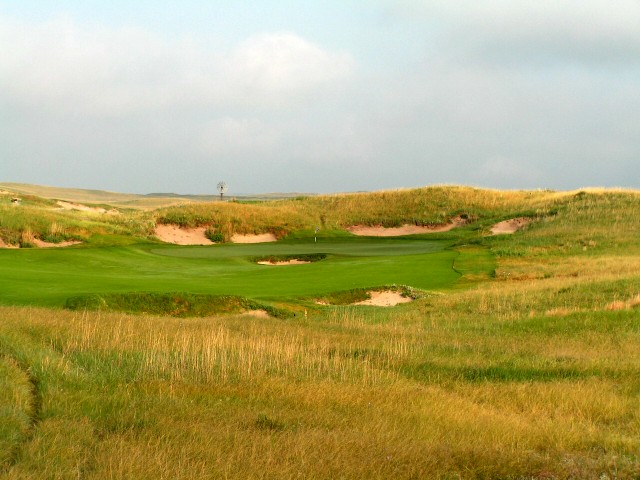
Unlike the 7th green complex perched on a knob, the 8th sits down in a natural amphitheater.

The brilliantly conceived boomerang 8th green is a favourite of Ben Crenshaw’s. The green functions well and the thinking golfer can use the back to front and right to left contours to work the ball toward most hole locations.
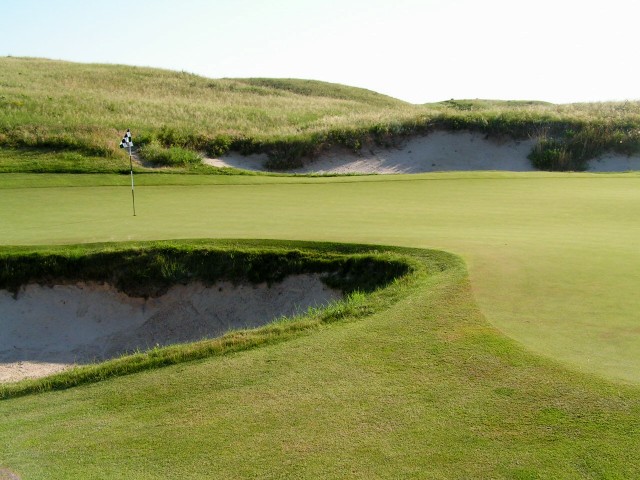
Many golfers conclude that it is better to lay back in the fairway and hit a fuller shot into the green, using the back to front pitch of the green and spin to work a ball close to the hole than it is to mess with the front central bunker.
Ninth hole, 400 yards; Sand Hills possesses an absurdly high number of world class holes, anywhere between 6 and 12 depending on one’s own personal definition.Though the 9th is not considered among them, it is one of the more uniqueholes on the courseand handsomely adds to the overall variety of the challenge. Principally, the large fairway enjoys the most humps and bumps on a human scale of any on the course. The chance of drawing a level stance for one’s approach to the green is slim and the potato chip green shrugs balls off onall sides. The need to control the flight of the ball off an uneven stance cuts to heart of the game’s origins.
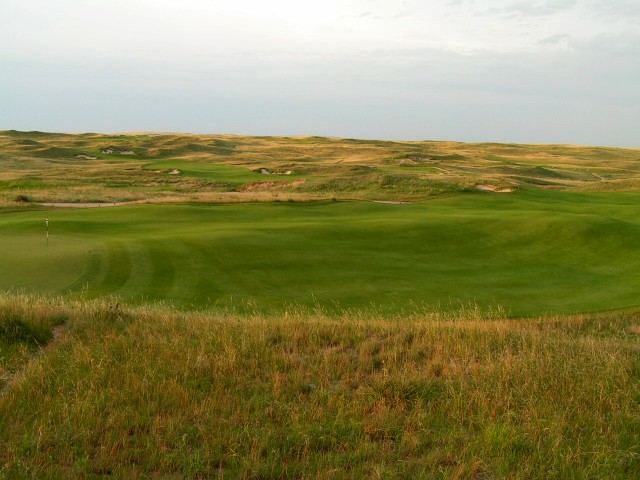
Standing on Ben’s Porch and looking down, the golfer sees the spine that feeds onto and into the 9th green.
Tenthhole, 470 yards; Lay of the land architecture at its best, as thishugetwo shotterfollows the tumbling land down the side slope. An ideal approach may pitch some twenty yards short and bound right and onto thewide green, atact that Coore & Crenshawhad successfully recently employedat the 5th, 17th and 18th holes at thePlantation Course at Kapalua. As with all Coore & Crenshaw designs, the architects encourage the golfer to try shots and just ‘play’ golf. The fact that golf is a game and it is meant to be fun is very much in evidence throughout the design at Sand Hills.
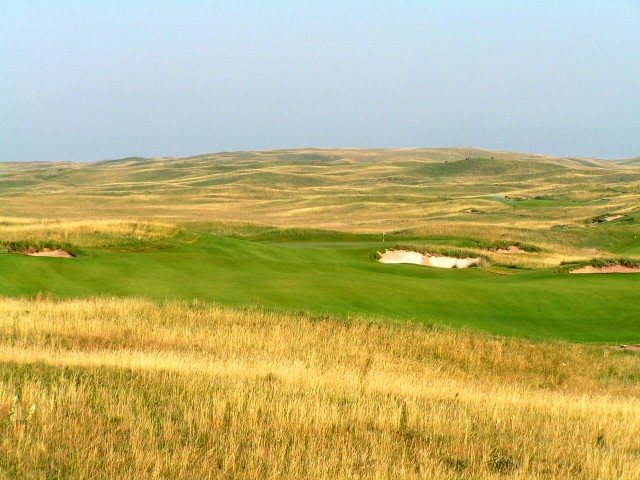
How rolling is the 10th fairway? A group of golfers are actually in one of the fairway hollows.

With deep bunkers along the right side of the green, using the natural left to right pitch of the land is the prudent way for working the ball onto the 10th green.
Eleventh hole, 410 yards; A wonderfully deceiving hole with everything in clear view from the tee – or is it?
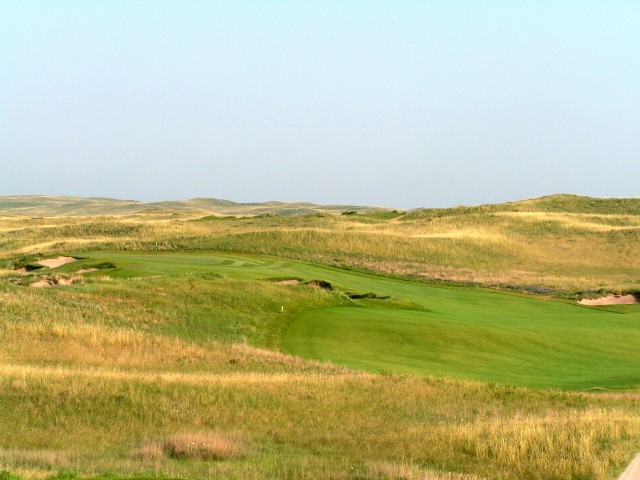
The entire dogleg left 11th unfolds before the golfer from the elevated tee.
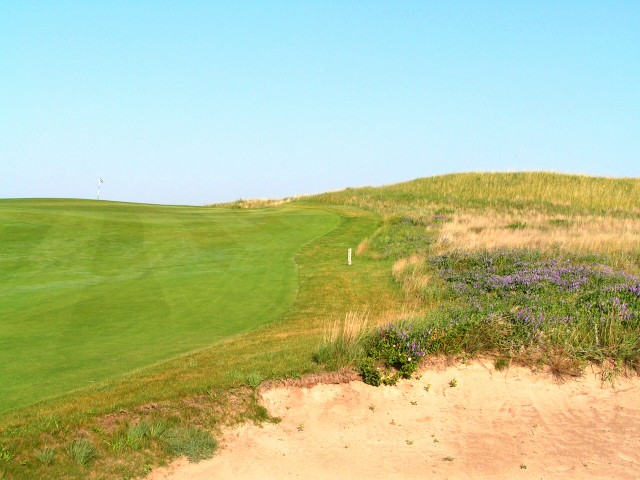
A long drive down the right hopefully stays in the fairway and leaves the golfer with…

…an uphill approach to a horizon green…
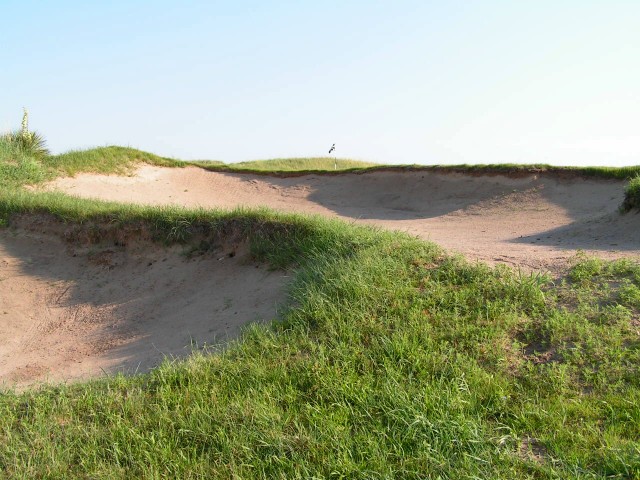
…with deep bunkers eating into the left of the green. These bunkers are evident from the tee but not on the approach shot.
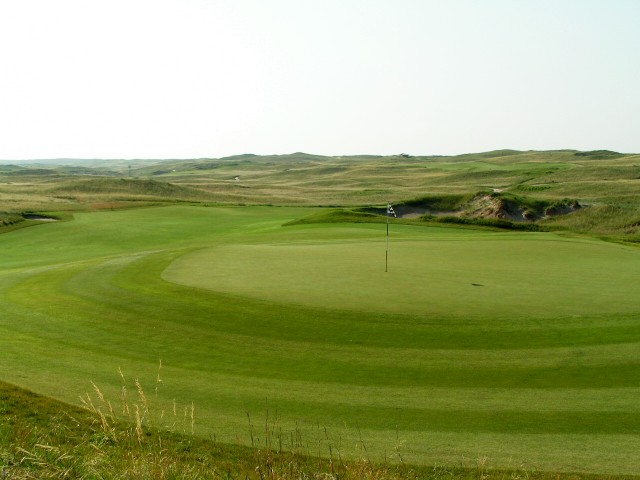
As seen from behind, the rub of the 11th is that its green is angled back toward the tee. Thus, any approach from right of the center of the fairway is at an oblique angle to the green. The golfer needs to be mindful of that fact. For instance, any shot missed right of the flag in the third photograph above is kicked into a grass swale, from which recovery is difficult.
Twelfth hole, 415 yards; Bunkers sometimes guide a golfer how to play a hole. At the 1st, 5th, 11th, and 16th holes for instance, the closer the golfer flirts with the bunkers on the inside of the dogleg, the easierhisnext shot. Standing on the 12th tee, however, the golfer only sees the widest fairway on the course at 90 yards (whichis – ironically – bunkerless) and the green straightahead. The golfer feels free to swing away with no obvious trouble in sight. The challenge rests with Coore’s brilliant use ofthe natural topography as he routed the middle of the fairway along a spine that runs for much of the hole. To either side of the spine are twenty foot deep bowls, down in which the sight of the green is blocked.

The divots are from approach shots that resulted from tee balls that fell left off the spine that runs down the 12th fairway. The resulting approach shot is blind.

A considerably easier approach is had from a well placed drive that stays atop the spine.
Thirteenth hole, 220 yards; The key to this hole was to find it. This long one shotterplays from one dune to the top of another. The green is severely contoured, which actually aids the golfer down wind hold the shot on the green.
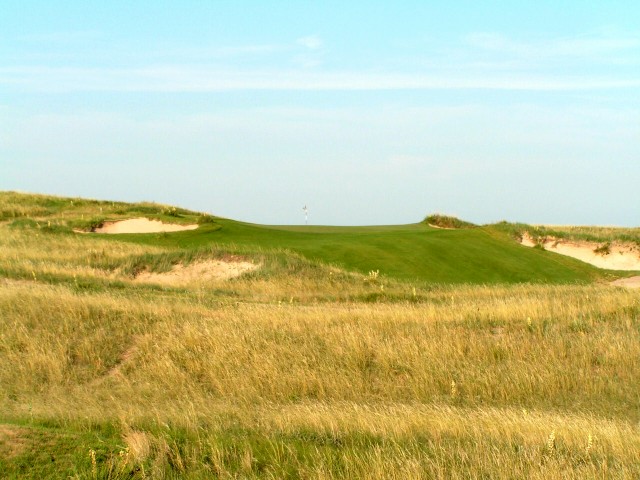
The beautiful horizon green of the 13th. Not evident in this photogrpah is the sixty yards of fairway short of the green. Some familiar with the course suggest playing the hole in a similar manner to the high demand 5th at Pine Valley – hit the ball short in hopes for a pitch and putt par.
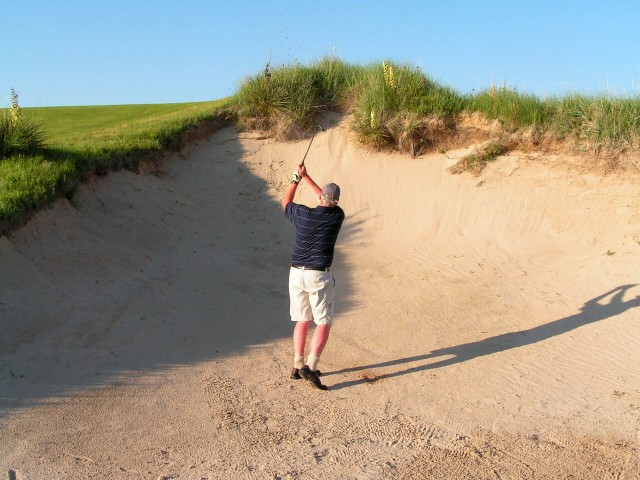
A fade into the wind left this golfer with a difficult forty yard bunker shot to the elevated 13th green.
Fouteenth hole, 510 yards; A favourite half par hole, many a golfer mighthave a go at the green in two, even with as little as a mid iron. However, par is admirably defended with the smallest green on the course at a mere 2,800 square feet. Both the green’s angle at the base of a dune and its severe pitch from back to front often require the golfer to take more shots to cover the last40 yards than was needed for the first 470 yards.

The wide fairway at the 14th encourages the golfer to swing out in a positive manner. Cramped courses with fairways sandwiched between rows of trees or houses seem like a different and vastly inferior sport.

Downwind, a drive may catch this gigantic bowl and roll another 60 yards. The optimal angle into the green is from its base but the uphill shot is blind. The superbly placed bunker cut into the slope fifty yards short and left of the green is a study in how to integrate a hazard into a natural landform.

As at the 7th, bold play can quickly take the golfer from thinking of a birdie to being gratefully for a par. Any approach short and right of the 14th green leaves a horrible angle across a shallow green that is a scant 18 paces from the front bunker to the back one.
Fifteenth hole, 470 yards; The 15th tee is the furthermost point to Ben’s Porch on the back side and a genuine roller coaster ride remains: the uphill climb at the 15th, the wild downhill ride at the 16th, the short 17th, and then the final march uphill at the 18th.Coore & Crenshaw lent thisthrilling landscapeits golfing qualities, in this case by digging out a pit bunker thirty yards shy of the green and using that fill tocreate another unique green complex,in this case a dome shaped green featuring a back to front tilt. The surrounding area of the green is kept tightly mown, with many a delicate chip shots to be had.
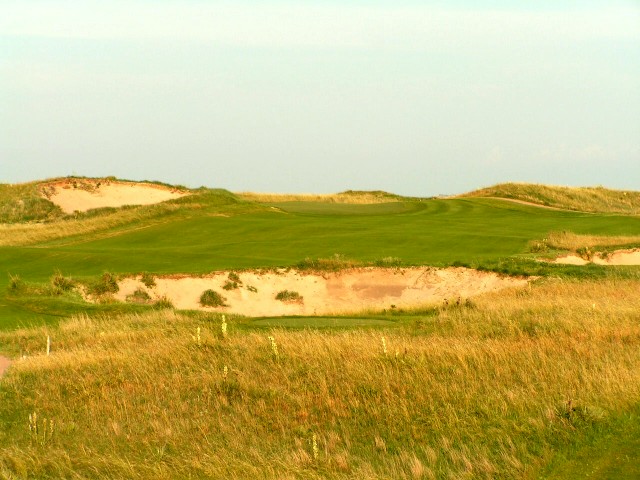
If the golfer flirts with the bunkers down the right, his approach shot into the partially hidden green won’t have to contend with the deep bunker thirty yards short of the green on the left.
Sixteenthhole, 610 yards; There is all the room in the world to the right on this long hole. However, with the hole curling left and with the most menacing hazards down the left, the golfer is continually tempted to take on the hazards in order to gain an advantage. For instance, off the tee, the brave teeball skates past the left hand bunker complexin order to get a potentialseventy yards extra in roll. From there, the next set of hazards can be carried and the greenis evenreachable in two with any kind of helping wind. A drive missed rightwill still catch the fairway but remains well back at the top of the hill. From there, a long iron or three woodis neededjust toget past another bunker complex 150 yardsshy ofthe green. Because of how well this option filled hole plays in all wind conditions, many place it with the 14th at The Old Course as one of the game’s great three shotters.
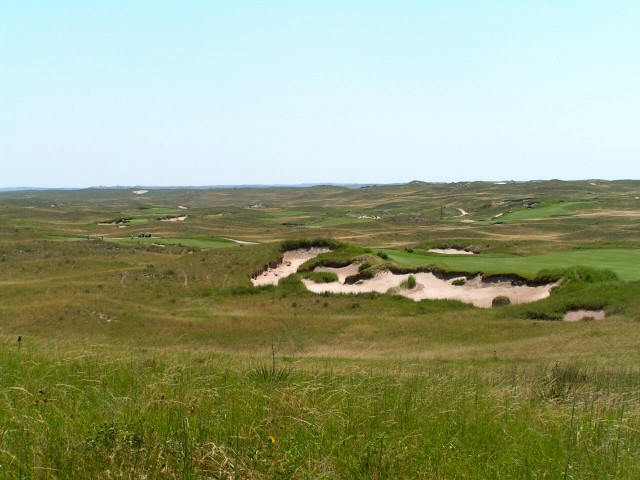
From the tee, the fairway tumbles downhill and toward the left. The tiger line off the tee is over the left of this formidable bunker complex as a successful carry rewards the golfer’s tee ball with a huge kick forward down a steep hill.
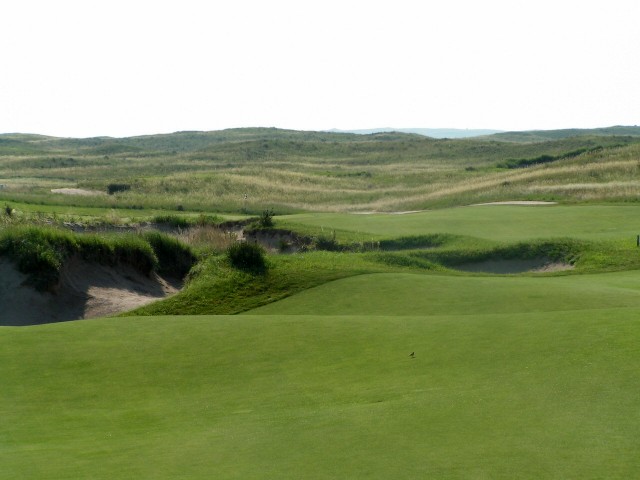
The second shot is dominated by this bunker complex, which stretches from 140 to 190 yards back from the green.

The 16th green is bunkerless, in sharp contrast to the next one at the 17th. Such design change of pace puts the onus on the golfer to continually recognize when to attack and when to parry. Also, too, the bunkerless green allows this 600 yard plus hole to remain playable in all wind conditions.
Seventeenthhole, 150 yards; The architects could have easily created a stereotypical 220 yard 17th – goodness knows,they had heaps of room. Instead, they wisely opted for a ‘touch of poetry’ (a back tee of 175 yard was briefly put into play in 1996 and abandoned withina year). With its green encased by bunkers infested with native growth, this short hole allows the better golfer to shine through with superior ball control. While flighting the ball through the wind with a short iron is always vexing, it remains withinthe capabilities ofmost level of player. The contrast of this tightly guarded greenagainst the openness of the prior green makes the target appear even more elusive.
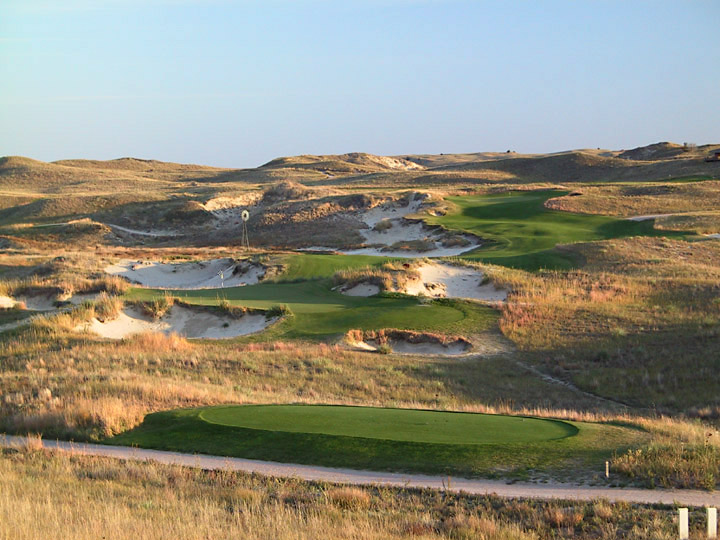
The tiny 3,200 square foot 17th green in the foreground with the mighty 18th in the distance.
Eighteenth hole, 465 yards; Though by no means indifferent holes, the Home holes at Royal County Down, Crystal Downs, Ballybunion and Cypress Point do not fittingly capture the joy of playing at those similarly world class courses. The 18th at Sand Hills does however, as it is entirely natural, built on a specatular scale, isfull of options, and fascinating around the green. With the approach shot sharply uphill, the hole can be unmerciful in certain conditions. However, it is worth noting that the most level portion of any fairway on the course can be found at the base of the hill.
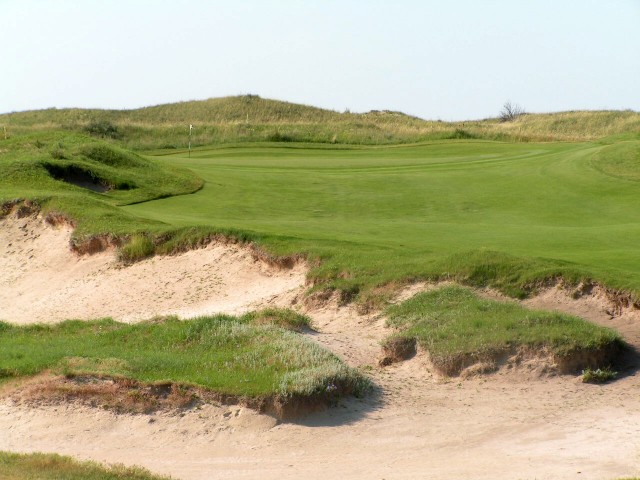
The golfer needs to negogiate past one last stunning hazard and get his approach well onto the 18th green, the front quarter of which acts as a false front.
One great attribute that Sand Hills hadgoing for itfrom the start was thatthe project’s overriding goal was not financial but rather the simple desire to build a great course. There would be no swimming pool ormonsterous clubhouseor housing development considerations. Given the relatively low cost of building the course and its facilities, the owners weren’t saddled at the start with massive debt. A small membership of160 is enough to sustain the course in quality condition. They can afford to limit the rounds to 50 to 70 a day from Junethrough September when the course is open.
In short,a stunning property was turned into a great course at little expense by moving minimal earth. The resulting financial flexibility allows the owners to promote an environment that every golfer enjoys: a unique experience in an uncrowded, natural environment undiluted by outside interferences. At the end of many a thirty-six hole day, the golfer realizes there is no other place he would rather be.
The End

